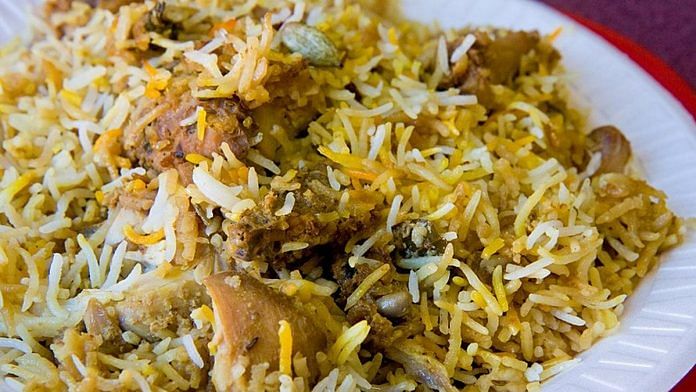Two years ago, a heated debate took over Indian social media when it was announced that chef Sanjeev Kapoor would attempt a world record by cooking 800 kg of khichdi during World Food India, an event organised by the Ministry of Food Processing Industries.
Netizens decided this meant khichdi was being promoted to the position of India’s national dish — a thought that was widely criticised for not taking into account the country’s culinary diversity. Of course, the debate soon disintegrated into biryani versus dosa versus dhokla and so on. But while the argument turned out to be a moot point, it seems there may be a winner after all.
In its annual report released Monday, food delivery platform Swiggy states that between January and November of 2019, Indians ordered 95 biryanis a minute on average — that is 1.6 biryanis every second. The love of biryani is not new, though — this is the third year in a row that it tops the list of Swiggy’s most-ordered items. The report also states that most first-time users opt for biryani.
Noted food writer and restaurant critic Marryam Reshii tells ThePrint it’s unsurprising, because biryani is a compact, complete meal, a meal in a bowl that is unfussy and neat.
“If you order a butter chicken, you need naan or some sort of carb to go with it – you won’t eat it on its own. Biryani is less complicated that way, plus you don’t need to take it out of the container it comes in — you can dig right into that with a spoon or fork, so it is less of a hassle.”
She adds that because there are so many different kinds of biryani — mutton, chicken, prawn, vegetable, egg — one can get their choice of protein. Both of these factors make it ideal for young working professionals living on their own, who don’t have time to cook and don’t want to spend too much time thinking about what to order.
Swiggy delivered more than 35,000 varieties and combinations across the country. The platform also catered to a wide budget, with a Chicken Sajuk Tup biryani going for Rs 1,500 in Pune, as opposed to Mumbai, where Rs 19 can get you a Chal Dhanno Tawa biryani — a veggie version that can be made quickly and is perfect for Mumbai’s fast-paced life.
If biryani is an easy choice for customers, it’s equally easy for restaurants. Biryani is hard to get terribly wrong, says Reshii. Plus it is a dish that is best made in bulk, in big handis or degchis, and then stored in the same vessel, so the flavours keep developing.
Also read: Global investors bet big on Behrouz biryani’s parent firm Rebel Foods
“Restaurants that are on Swiggy aren’t going to make fresh biryani each time an order comes in, so they’ll make a big lot in bulk in the morning, and it doesn’t go bad quickly. In fact, if you’re lucky, you’ll order at a time when you’ll get the stuff that’s at the bottom of the degchi.”
The popularity of biryani can also be attributed to the fact that it is popular across a large swathe of India — Lucknow, Hyderabad, Kolkata, northern Kerala and Tamil Nadu all have versions of the dish, with their own origins and ingredients.
For example, Reshii explains, while northern Kerala was introduced to biryani by Arab traders who came to the coast for spices, the Awadhi biryani of Lucknow came from the Persians. Dindigul in Tamil Nadu does biryani with kalpasi or black stone flower, a kind of lichen, while Bengalis can’t do without potatoes in their version.
Swiggy’s report comes at a time when India is grappling with bitterly polarising questions of citizenship and discrimination against Muslims. In that climate, India’s love of biryani seems like a reminder that India was never one homogenous or monolithic identity, with one kind of cuisine.
“You can’t politicise food,” says Reshii. “If you ask a kid from, say, Sweden, about the first thing that comes to mind when they think of India, chances are they’ll say the Taj Mahal. Babur may have come to plunder, but his descendants stayed on for centuries. They made this country what it is today.”
Khichdi lovers needn’t feel bad, though. Swiggy also stated that the dish saw a jump of 128 per cent in orders this year, especially during Navratri.
Also read: There’s a saffron surge in Kashmir this year, but it’s the spice, not politics



